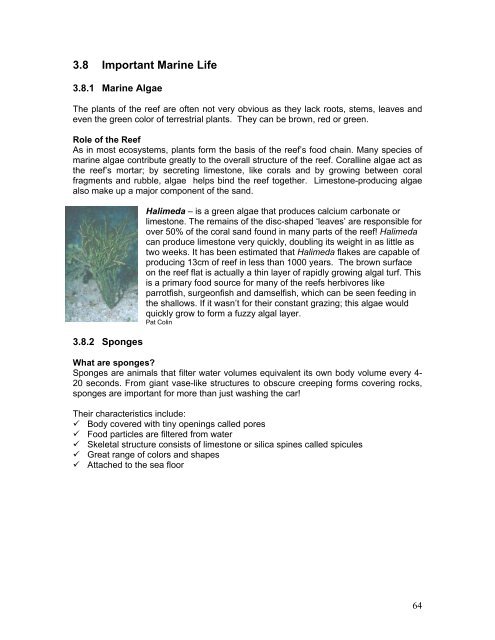KOROR STATE GOVERNMENT MARINE TOUR GUIDE ... - C3
KOROR STATE GOVERNMENT MARINE TOUR GUIDE ... - C3
KOROR STATE GOVERNMENT MARINE TOUR GUIDE ... - C3
Create successful ePaper yourself
Turn your PDF publications into a flip-book with our unique Google optimized e-Paper software.
3.8 Important Marine Life<br />
3.8.1 Marine Algae<br />
The plants of the reef are often not very obvious as they lack roots, stems, leaves and<br />
even the green color of terrestrial plants. They can be brown, red or green.<br />
Role of the Reef<br />
As in most ecosystems, plants form the basis of the reef’s food chain. Many species of<br />
marine algae contribute greatly to the overall structure of the reef. Coralline algae act as<br />
the reef’s mortar; by secreting limestone, like corals and by growing between coral<br />
fragments and rubble, algae helps bind the reef together. Limestone-producing algae<br />
also make up a major component of the sand.<br />
3.8.2 Sponges<br />
Halimeda – is a green algae that produces calcium carbonate or<br />
limestone. The remains of the disc-shaped ‘leaves’ are responsible for<br />
over 50% of the coral sand found in many parts of the reef! Halimeda<br />
can produce limestone very quickly, doubling its weight in as little as<br />
two weeks. It has been estimated that Halimeda flakes are capable of<br />
producing 13cm of reef in less than 1000 years. The brown surface<br />
on the reef flat is actually a thin layer of rapidly growing algal turf. This<br />
is a primary food source for many of the reefs herbivores like<br />
parrotfish, surgeonfish and damselfish, which can be seen feeding in<br />
the shallows. If it wasn’t for their constant grazing; this algae would<br />
quickly grow to form a fuzzy algal layer.<br />
Pat Colin<br />
What are sponges?<br />
Sponges are animals that filter water volumes equivalent its own body volume every 4-<br />
20 seconds. From giant vase-like structures to obscure creeping forms covering rocks,<br />
sponges are important for more than just washing the car!<br />
Their characteristics include:<br />
Body covered with tiny openings called pores<br />
Food particles are filtered from water<br />
Skeletal structure consists of limestone or silica spines called spicules<br />
Great range of colors and shapes<br />
Attached to the sea floor<br />
64











